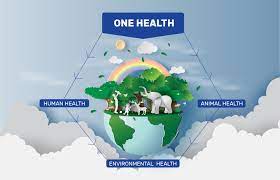One World One Health: Prevent Zoonosis
Dr. Priyanka Rani, M.V.Sc Scholar, LPM, COVAS, SVPUAT, Meerut UP
Dr. V. K. Varun, Assistant Professor, VCC, COVAS, SVPUAT, Meerut, UP
The rise of emerging and resurging infectious diseases threatens not only humans, but also the flora and fauna comprising the critically needed biodiversity that supports the living infrastructure of our world. To win the disease battles of the 21st Century while ensuring the biological integrity of the Earth for future generations requires interdisciplinary and cross- sectional approaches to disease prevention, surveillance, monitoring, control and mitigation and to conserve environment. The Wildlife Conservation Society (WCS) introduce the term “One World-One Health” in 2007 along with 12 recommendations (The Manhattan Principles) that focused on establishing a more holistic approach to preventing epidemic disease and maintain ecosystem integrity. In 2007 The One Health approach is recommended for Pandemic Preparedness Influenza meeting, New Delhi. In 2009 – 2012 The One Health Approach is recommended for Pandemic Preparedness, One world One Health. USAID establishes emerging pandemic program etc. India established a national standing committee on Zoonoses as far back as the 1980s.
One World One Health concept is being recognized as an effective way to fight health issue at the Human- Animal- Environment interface, including Zoonotic diseases. It connects Human health, Animal health and Environmental health. One world One health issue include Zoonotic diseases, Antibiotic Resistance, Food Safety & security, Vector- born disease, Environmental Health, Chronic disease, Mental health & Occupational health etc. Zoonotic diseases are infectious diseases caused by bacteria, viruses and parasites that spread between animal and human. Human health includes resilience and adaptation individual & community well being. Animal health includes subsistence food safety & sustainability stable, healthy, wildlife populations etc. Environmental health includes safe air, water, plant-based food, shelters and sanitationetc. The One World One Health approach can prevent outbreaks of zoonotic disease in animals and people, improve food safety and security, reduce antibimicrobial-resistant infections and improve human and animal health, protect global health security and protect biodiversity and conservation.
The Manhattan Principles are global need of world are:
- Recognize the essential link between human, wildlife health and domestic animal the threat disease poses to people, their food supplies and economies, and the biodiversity essential to maintaining the healthy environments and functioning ecosystems.
- Recognize that decisions regarding land and water use have real implications for Alterations in the resilience of ecosystems and shifts in patterns of disease emergence and spread manifest themselves when we fail to recognize this relationship.
- Recognize wildlife health science as an essential component of global disease prevention, surveillance, monitoring, control and mitigation.
- Recognize that human health programs can greatly contribute to conservation efforts.
- Devise adaptive, holistic and forward-looking approaches to the prevention, surveillance, monitoring, control and mitigation of emerging and resurging diseases that take the complex interconnections among species into full accounts.
- Seek opportunities to fully integrate biodiversity conservation perspectives and human needs (including those related to domestic animal health) when developing solutions to infectious disease threats.
- Reduce the demand for and better regulate the international wildlife and bushmeat trade not only to protect wildlife populations but to lessen the risks of disease movement, cross-species transmission, and the development of novel pathogen-host relationships.
- Restrict the mass culling of free-ranging wildlife species for disease control to situations where there is a multidisciplinary, international scientific consensus that a wildlife population poses an urgent, significant threat to human health, food security, or wildlife health more broadly.
- Increase investment in the global human and animal health infrastructure commensurate with the serious nature of emerging and resurging disease threats to people, domestic animals and wildlife. Enhanced capacity for global human and animal health surveillance and for clear, timely information-sharing (that takes language barriers into account) can only help improve coordination of responses among governmental and nongovernmental agencies, public and animal health institutions, vaccine / pharmaceutical manufacturers, and other stakeholders.
- Form collaborative relationships among governments, local people, and the private and public sectors to meet the challenges of global health and biodiversity conservation.
- Provide adequate resources and support for global wildlife health surveillance networks that exchange disease information with the public health and agricultural animal health communities as part of early warning systems for the emergence and resurgence of disease threats.
- Invest in educating and raising awareness among the world’s people and in influencing the policy process to increase recognition that we must better understand the relationships between health and ecosystem integrity to succeed in improving prospects for a healthier planet.
It has been noted by the World Health Organization (WHO) and Graham et al. that approximately 75% of new emerging human infectious diseases are defined as zoonotic. New and reemerging zoonoses have evolved throughout the last three decades partly as a consequence of the increasing interdependence of humans on animals and their products and our close association with companion animals. Zoonoses should therefore be considered the single most critical risk factor to human health and well-being, with regard to infectious diseases.
It is clear that no one discipline or sector of society has enough knowledge and resources to prevent the emergence or resurgence of diseases in today’s globalized world. No one nation can reverse the patterns of habitat loss and extinction that can and do undermine the health of people and animals. Only by breaking down the barriers among agencies, individuals, specialties and sectors can we unleash the innovation and expertise needed to meet the many serious challenges to the health of people, domestic animals, and wildlife and to the integrity of ecosystems. Solving today’s threats and tomorrow’s problems cannot be accomplished with yesterday’s approaches. We are in an era of “One World, One Health” and we must devise adaptive, forward-looking and multidisciplinary solutions to the challenges that undoubtedly lie ahead.


